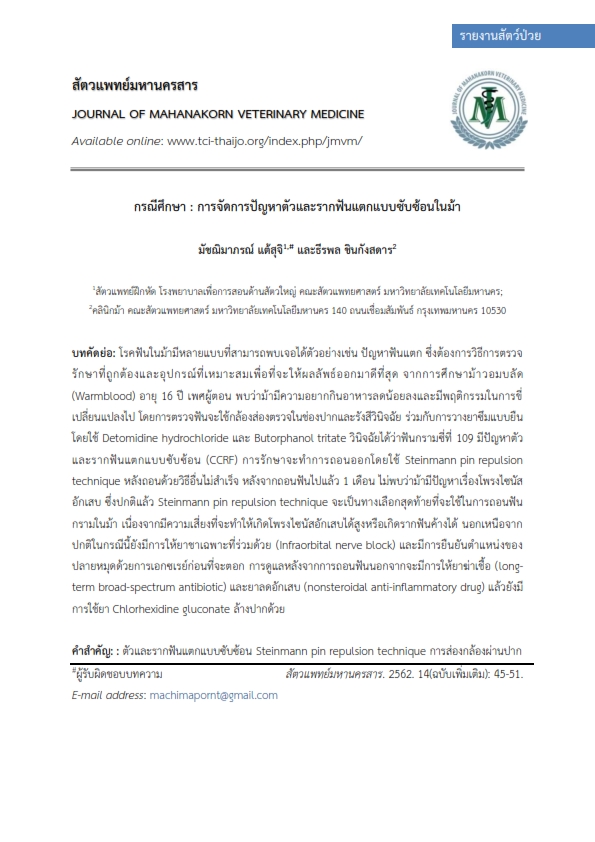The Management of Complicated Crown Root Fracture in Equine Molar: A Case Report
Main Article Content
Abstract
Equine dental disease such fracture tooth required correct technique and right equipment to achieve the best outcome. A sixteen years old warmblood gelding presented with loss of appetize and change of riding behavior. The oral examination using oral endoscope and radiographic image was carried out under standing sedation using combination of Detomidine hydrochloride and Butorphanol tritate. The diagnosis was complicated crown and root fracture of , the tooth was successfully removed using Steinmann pin repulsion technique (SPR) after failure of others technique. After one month post-operatively, the horse recovered well without any sign of sinusitis. SPR should be the last resort for removing equine tooth due to high rate of complication such recurrent sinusitis, remaining of root fragment, and extraction of non-disease tooth. In order to minimize complication, the horse must be under heavy sedation with local anesthesia (infraorbital nerve block for this case) then the disease tooth was located, and pins guided using radiograph. Post-operative care includes oral rinse with Chlorhexidine gluconate, oral medication of long-term broad-spectrum antibiotic, and nonsteroidal anti-inflammatory drug.
Article Details
References
Boutros, C. P., and J. B. Koenig. 2001. A combined frontal and maxillary sinus approach for repulsion of the third maxillary molar in a horse: Can. Vet. J. 42(4): 286-288.
Chinkangsadarn, T., G. J. Wilson, R. M. Greer, C. C. Pollitt, and P. S. Bird. 2015. An abattoir survey of equine dental abnormalities in Queensland: Australian Vet. J. 93(6): 189-194.
David W. R. 2016 (cited 8 march 2019). Indications and complications of cheek teeth extractions in equines. Available from: https:// www.veterinarypractice news.com/indications-and-complications-of-cheek-teeth-extractions-in-equines.
Lyon L. 2006 (cited 19 march 2019). Equine anesthesia. Available from: https:// instruction.cvhs.okstate.edu/vmed5412/pdf/23EquineAnesthesia2006.pdf.
Prichard, M. A., R. P. Hackett, and H. N. Erb. 1992. Long-term outcome of tooth repulsion in horses A retrospective study of 61 cases: Vet. Sur. 21(2): 145-149.
Stephen, S. G. 2010. How to evaluate dental cavities in horses: AAEP processing. 56: 450-457.
Thomas W. 2013 (cited 1 march 2019). Developments and options in equine cheek teeth: Available from: https:// www.vettimes.co.uk/app/uploads/wp-post-to-pdf-enhanced-cache/1/ developments-and-options-in-equine-cheek-teeth-extraction.pdf


